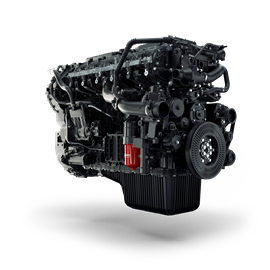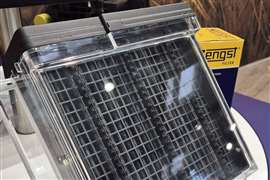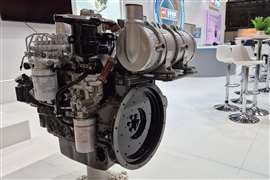Read this article in Français Deutsch Italiano Português Español
The tech behind the XCursor 13 Natural Gas engine from FPT Industrial
25 July 2025
In this article we take a deep dive into the technology featured on the XCursor13 NG, the latest heavy-duty natural gas engine produced by FPT Industrial
 XCursor 13 NG is suitable for HD trucks and intercity bus applications (Photo: FPT Industrial)
XCursor 13 NG is suitable for HD trucks and intercity bus applications (Photo: FPT Industrial)
As part of the Iveco Group, FPT Industrial is the manufacturer of engines, transmissions and axles used across the company’s various divisions and also delivered to third-party customers. The product lineup covers a range of on- and off-highway applications, including trucks, buses and tractors, through to power generation and marine models.
According to Andrea Abbà, product manager for the On-Highway Portfolio, the company now offers a series of engines which can use various alternative fuels, including natural gas. “We have a complete lineup of natural gas engines, from three to 13 litres. These fit variety of truck and bus applications, from light through to medium- and heavy-duty trucks, and from minibus and city bus through to intercity coaches. I’d say we have the widest lineup of natural gas engines in the market.”
Asked whether the range of natural gas (NG) engines is due to customer demand or an intent to support the broad range of vehicles produced by Iveco, he states that it’s down to both streams. “We’re delivering to Iveco and brands within the Iveco Group and also to third-party customers producing on- and off-highway models,” he reports.
Natural gas engines
FPT Industrial can trace its history with gas-fuel engines back to 1997, longer than most companies producing engines with similar fuel systems. Abbà says that since then, the company has sold more than 100,000 units of its NG engines.
It was in 2018 that the company unveiled its Cursor X concept, the modular engine series which would go on to include versions using diesel and natural gas; plans are in place to develop a hydrogen variant. The ‘X’ in the concept name – and that which appears on the latest models – effectively acts as variable highlighting the multi-fuel capability of the engine range.
The production-ready version of the single-base, multi-fuel XCursor 13 was unveiled at the IAA Transportation show in 2022. With a displacement of 12.9 litres, the engine was first launched as a diesel model – it can also use HVO/renewable diesel and B7 biodiesel. This was followed in 2024 by the XCursor 13 NG, which can use CNG (compressed natural gas), LNG (liquid natural gas) or biomethane without any modification. Abbà notes that using biomethane will reduce CO2 output by almost 100%.
FPT Industrial Natural Gas (NG) engine range
F28 NG 2.8-litre four-cylinder for agricultural, construction machinery
F1C NG 3.0-litre four-cylinder for LCVs, minibus
NEF N60/N67 NG 6.0- and 6.7-litre six-cylinder for tractors, medium machinery, trucks, city bus
Cursor 9 NG 8.7-litre six-cylinder for truck, bus
XCursor 13 NG 12.9-litre six-cylinder for heavy-truck, intercity bus
While the diesel employs a compression ignition system, the natural gas engine uses spark ignition. There are natural gas engines which use compression ignition, but these generally involve complicated management of LNG, urea (AdBlue) and diesel fuel, together with a cryogenic pump for the LNG fuel tank and a diesel aftertreatment system.
“Spark ignition is a solution we’ve had under development for a long time,” says Abbà. “It delivers a great balance between engine performance and efficiency, between cost and benefit. We’ve had long experience with this system, it’s very reliable.”
Weight reduction
The XCursor 13 NG has been specifically designed for use in heavy-duty trucks and intercity coaches; the Iveco S-Way trucks are now available with the engine. Power output for natural gas version is 368 kW/500 hp with 2,200 Nm of peak torque (a version producing 520 hp and 2,500 Nm could still be homologated should there be customer demand). The engine footprint also indicates it is for heavy-duty applications, as does the weight – the XCursor 13 NG comes in at 1,050 kg.
“We did a lot of work to reduce the weight of the latest engine compared to the previous version,” says Abbà. “We brought down the overall weight by a little more than 100 kg, which works out to be about a 10% reduction. We think it’s an important achievement.”
Modifications made to reduce the weight included a new engine block design that uses less material. Also, the cast iron head and block have been replaced with lighter versions using compacted graphite iron (CGI). This is a type of cast iron where the graphite appears in curled or ‘vermicular’ shapes which help with casting and machining the finished component. CGI also offers favourable heat transfer properties.
“CGI is more resistant to pressure and heat, so we can increase the mechanical performance of the engine,” explains Abbà. “[The engine] weighs about one ton, which sounds a lot, but it is aligned with the best in class for the market.”
More new tech
The engine range replaced by the latest XCursor was known simply as Cursor. Natural gas versions of this engine used a turbo with a mechanical wastegate, but this has now been updated to use a turbo with an electronic wastegate.
“The electronic action driving the wastegate in the new turbo delivers a more precise movement,” says Abbà. “It improves the readiness of the turbo, the response time, which leads to better efficiency. In addition, the turbo also uses a new water cooling system. Natural gas results in higher temperatures than diesel and this new system helps to cool the turbo and the air going through the unit, which in turn improves engine performance.”
An efficient turbocharger can help to deliver improved power output over a naturally-aspirated model, simply due to the engine not having to work as hard to deliver the same power output. That said, the XCursor 13 NG also uses a three-way catalyst to reduce engine emissions.
“The three-way catalyst is really a standard when it comes to natural gas engines,” says Abbà. “From the introduction of the NG engine in 2024, we also added a CPF (CNG particulate filter). This is also standard, no matter the application.”
Another new addition to the XCursor 13 NG is an exhaust gas recirculation (EGR) system. This redirects a percentage of the exhaust stream back into the manifold where it helps to lower combustion temperatures and reduce NOx output. “This is the only NG engine we produce which uses an EGR system,” continues Abbà. “It helps reduce the thermal load on the engine so it can achieve improved levels of performance and efficiency.”
The multipoint direct injection system has been carried over from the preceding Cursor engine, but Abbà says that it now uses “full life” injectors, meaning they should not need to be replaced over the lifetime of the engine – the previous Cursor 13 needed to have the injectors changed at specified service intervals.
Together with the injector upgrade, the design of the combustion chamber was altered to prevent what Abbà calls “mega knock”, where the air/fuel mix ignites prematurely. “The design of the combustion chamber improves the air/fuel mix to help prevent knocking. Together with the lighweighting, the new turbo, changes to the combustion chamber and other features have helped improve overall fuel economy for the new engine by 8%,” he explains.
High compression is an underlying cause of engine knock. To help prevent this, the compression ratio of the XCursor 13 NG is 12:1, quite low when compared to a diesel engine which can operate at between 14:1 and 25:1.
Engine management
The ECU, or engine control unit, regulates the various systems across the engine, helping to support synchronicity between individual functions to achieve peak overall performance in terms of power, economy and emissions, while also reducing noise, vibration and harshness.
 Iveco S-Way HD truck is available with LNG fuel system and XCursor 13 NG engine (Photo: Iveco)
Iveco S-Way HD truck is available with LNG fuel system and XCursor 13 NG engine (Photo: Iveco)
Abbà says that the ECU on the XCursor 13 NG is different from that used by the diesel version. The system features an all-new engine map that, for example, can recognise if engine knock is about to occur and change parameters to optimise combustion.
“It’s a completely different combustion pattern to diesel, so the engine needs a different control unit,” says Abbà.
The service interval for the latest natural gas engine is set at 100,000 km (about 62,000 miles). While NG engines will usually have a shorter interval than diesel equivalents, the introduction of a new 0W 16 engine oil has helped with extending the servicing timeframe. In closing, Abbà notes that most heavy-duty trucks will spend days running at a constant highway speed, the most efficient in terms of fuel usage and overall engine longevity, but the truck’s actual duty cycle will have the largest influence on servicing requirements.
POWER SOURCING GUIDE
The trusted reference and buyer’s guide for 83 years
The original “desktop search engine,” guiding nearly 10,000 users in more than 90 countries it is the primary reference for specifications and details on all the components that go into engine systems.
Visit Now
STAY CONNECTED




Receive the information you need when you need it through our world-leading magazines, newsletters and daily briefings.
CONNECT WITH THE TEAM














